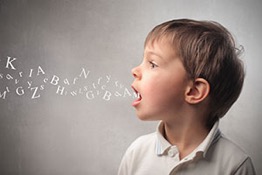Blog
Childhood Apraxia of Speech (CAS)
Childhood apraxia of speech (CAS) is a motor-speech disorder. Children who are diagnosed with CAS demonstrate difficulties saying sounds, syllables, and words. This is not because of muscle weakness or paralysis. The problem occurs within the brain. The brain has trouble planning to move the body parts (e.g., lips, jaw, tongue) needed for speech. The child knows what he or she wants to say, but his/her brain has difficulty coordinating the muscle movements necessary to say the words. (American Speech-Language-Hearing Association, 2016) CAS is a disorder of speech coordination, not strength. (Donald A. Robin, 2003)

There are three main characteristics of Childhood Apraxia of Speech (CAS) that must be demonstrated in order to contribute to a diagnosis. These characteristics include the following:
- Variability in productions. Inconsistent errors in repeated productions may also be known as “token-to-token inconsistency”. This is a variability of the child’s productions of speech sounds produced across multiple attempts. For example, a child may produce “banana” as “bana” and “nana” within the same session. (Fish, 2016)
- Vowel errors and inappropriate spacing.” A child with CAS will often demonstrate pausing or noticeable gaps between sounds or syllables. When coarticulatory transitions are disrupted the child may also demonstrate productions that negatively impact speech intelligibility (e.g., voicing errors, resonance differences, difficulties producing increasingly complex phoneme sequences). (Fish, 2016)
- Suprasegmental differences. The most noticeable is the use of excessive equal stress. Children who use excessive equal stress have a robotic quality to their speech. Prosody can impact both speech intelligibility and the listener’s impression of the speech. Children with CAS may also demonstrate difficulties with intonation, rhythm, juncture, and tone of voice. (Fish, 2016)
Through evaluation an SLP will be able to differentiate a diagnosis of CAS from a severe speech sound disorder.
Some errors that may be observed with a child who is diagnosed or suspected to have Childhood Apraxia of Speech (CAS) include the following:
- Substitutions (one sound is substituted for another)
- Additions (a sound is added such as “spulash” for “splash”)
- Distortions (sounds are produced but are not quite accurate such as too much air during the production of “s”)
- Omissions (sounds are left out such as “pe” for “pen”).
Children with CAS most often demonstrate inconsistent distortions and substitutions. (Donald A. Robin, 2003)
Speech therapy for a child with CAS should be consistent, frequent, and repetitive. Children with CAS need frequent one-on-one therapy and a lot of repetitive practice with sounds, sequences, and movement patterns in order to incorporate them into their speech and make them automatic. Many therapists recommend the use of sign language, PECS (picture communication systems), and other augmentative or alternative communications. This combination of therapies (sign and vocal word attempt) enhances the chance that the listener will be able to understand the speaker. Visual cues can be very helpful. Telling the child “Look at my lips” and pointing to your lips when saying the /b/ or /m/ sound can help facilitate the correct placement. Practicing while looking in the mirror is another way for the child to receive helpful visual cues regarding speech production.
Gabrielle Cormace M.S., CF-SLP
Sources
American Speech-Language-Hearing Association. (2016). Childhood Apraxia of Speech. Retrieved from ASHA.org: http://www.asha.org/public/speech/disorders/ChildhoodApraxia/
Donald A. Robin, P. C.-S.-N. (2003). Understanding Apraxia. Retrieved from Apraxia-kids.org: http://www.apraxia-kids.org/library/what-is-inconsistency-and-variability-of-speech-in-relation-to-cas/
Fish, M. (2016). Here’s How to Treat Childhood Apraxia of Speech (2nd ed.). San Diego, CA: Plural Publishing.
Super Duper Handy Handouts! #160: Understanding Childhood Apraxia by Becky Spivey, M.Ed. #50: Developmental Apraxia of speech and Developmental Verbal Dyspraxia: The Mystery of the Minimally and/or Non-Verbal Child




